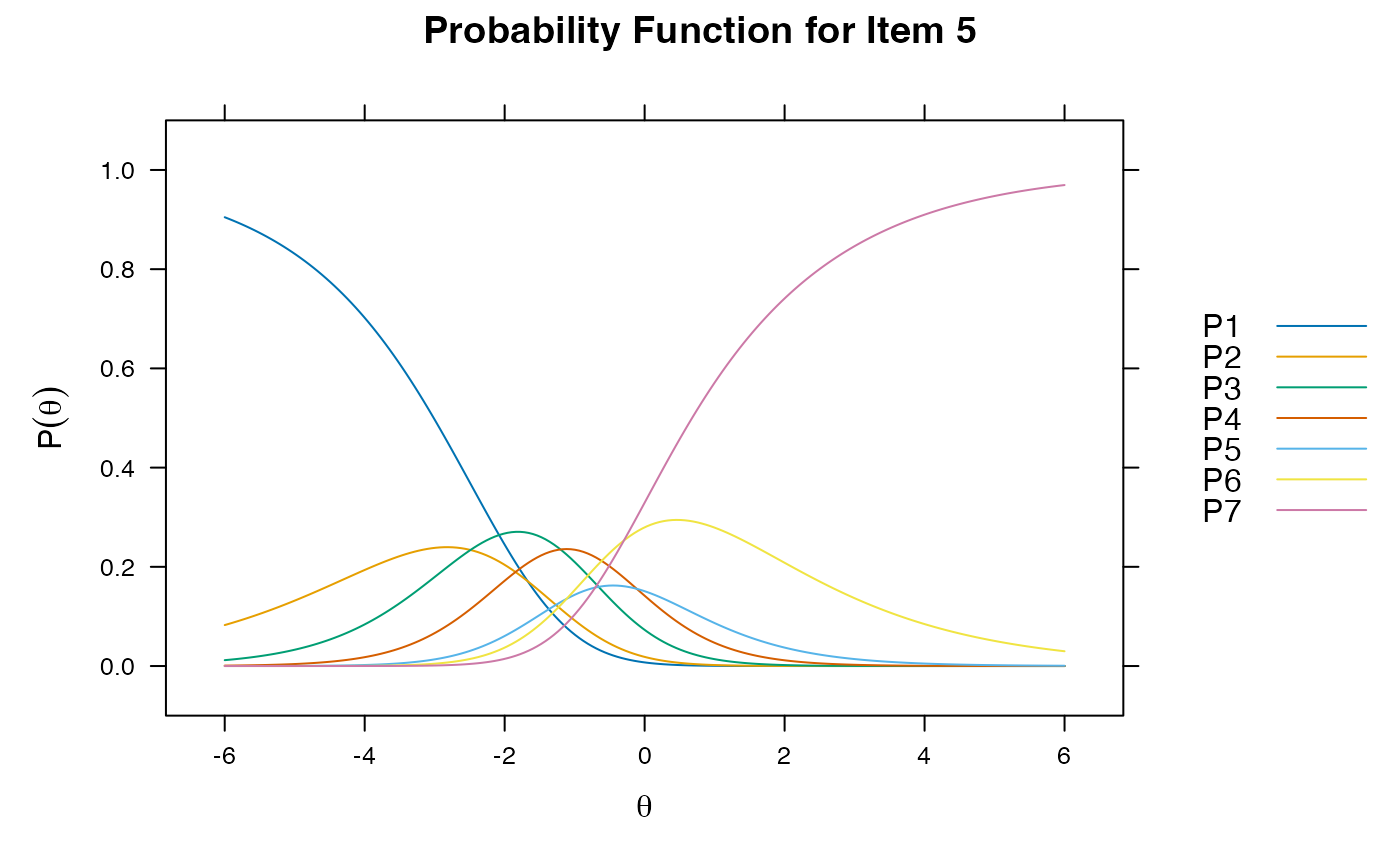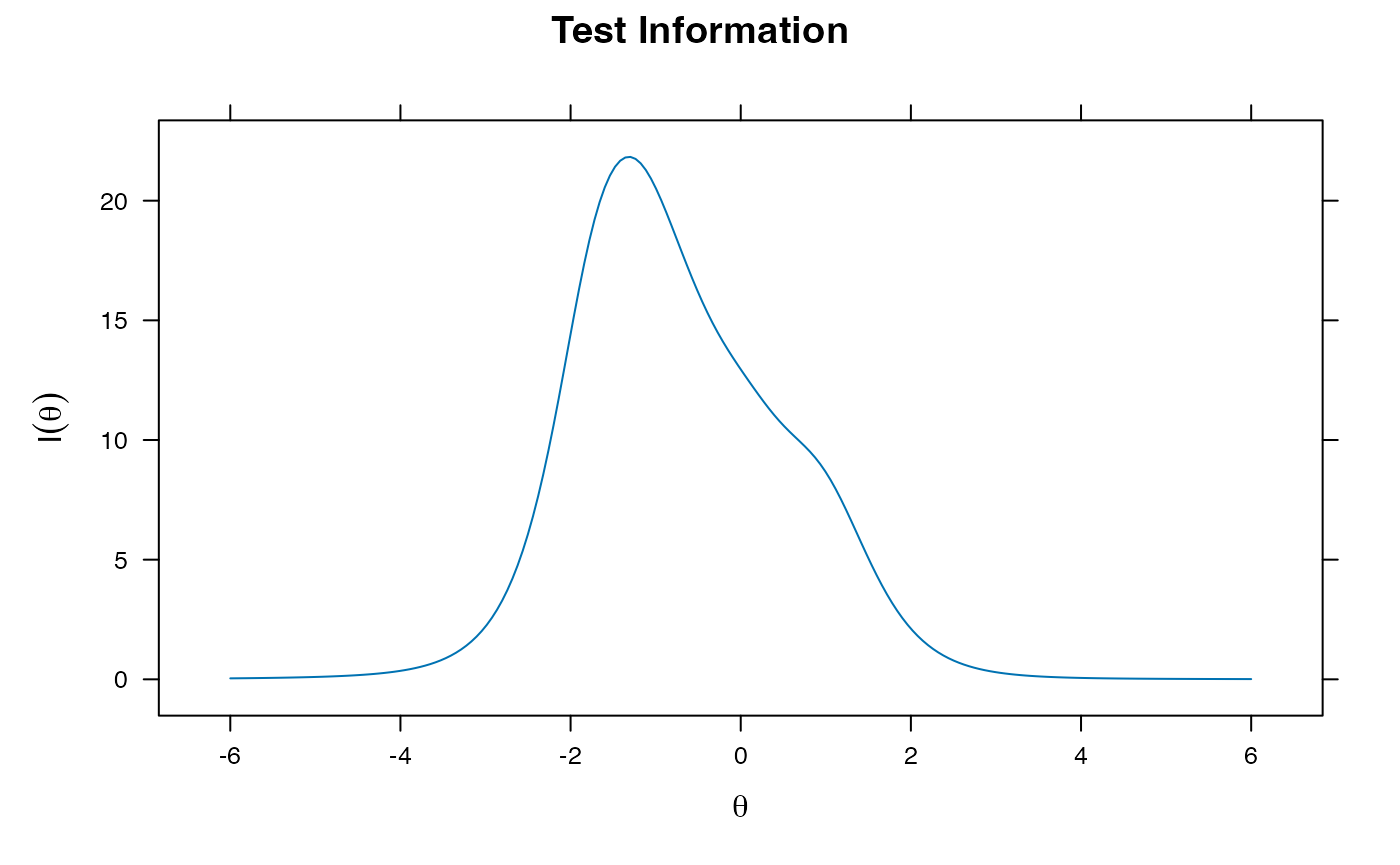Item Response Theory
lecture_irt.RmdItem Response Theory
- What do you do if you have dichotomous (or categorical) manifest
variables?
- Many agree that more than four response options can be treated as
continuous without a loss in power or interpretation.
- Do you treat these values as categorical?
- Many agree that more than four response options can be treated as
continuous without a loss in power or interpretation.
- Do you assume the underlying latent variable is continuous?
Categorical Options
- There are two approaches that allow us to analyze data with
categorical predictors:
- Item Factor Analysis
- More traditional factor analysis approach using ordered responses
- You can talk about item loading, eliminate bad questions, etc.
- In the
lavaanframework, you update yourcfa()to include theorderedargument
- Item Response Theory
- Item Factor Analysis
Item Response Theory
- Classical test theory is considered “true score theory”
- Any differences in responses are differences in ability or underlying trait
- CTT focuses on reliability and item correlation type analysis
- Cannot separate the test and person characteristics
- IRT is considered more modern test theory focusing on the latent
trait
- Focuses on the item for where it measures a latent trait, discrimination, and guessing
- Additionally, with more than two outcomes, we can examine ordering, response choice options, and more
Issues
- Unidimensionality: assumption is that there is one underlying trait
or dimension you are measuring
- You can run separate models for each dimension
- There are multitrait options for IRT
- Local Independence
- After you control for the latent variable, the items are uncorrelated
Item Response Theory
- A simple example of test versus person
- 3 item questionnaire
- Yes/no scaling
- 8 response patterns
- Four total scores (0, 1, 2, 3)
Item Response Theory
- Item characteristic curves (ICCs)
- The log probability curve of theta and the probability of a correct response
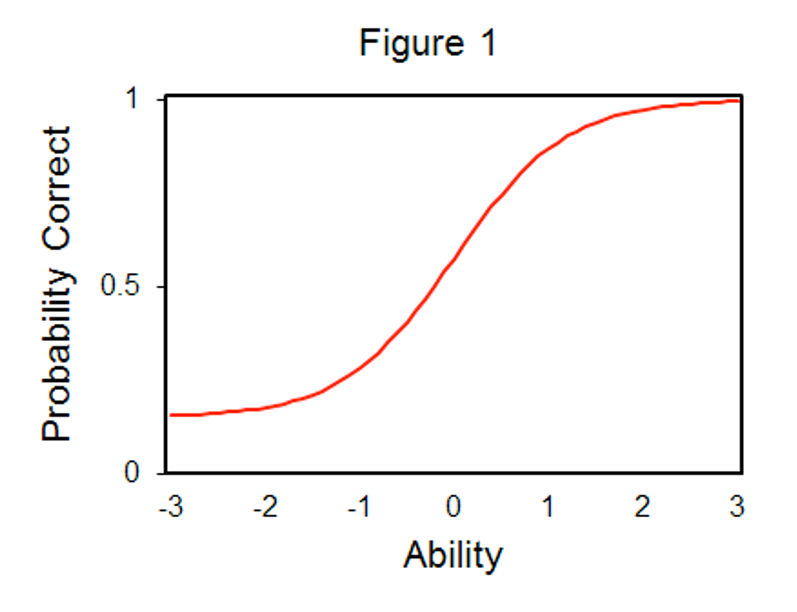
Item Response Theory
- Theta – ability or the underlying latent variable score
- b – Item location – where the probability of getting an item correct
is 50/50
- Also considered where the item performs best
- Can be thought of as item difficulty
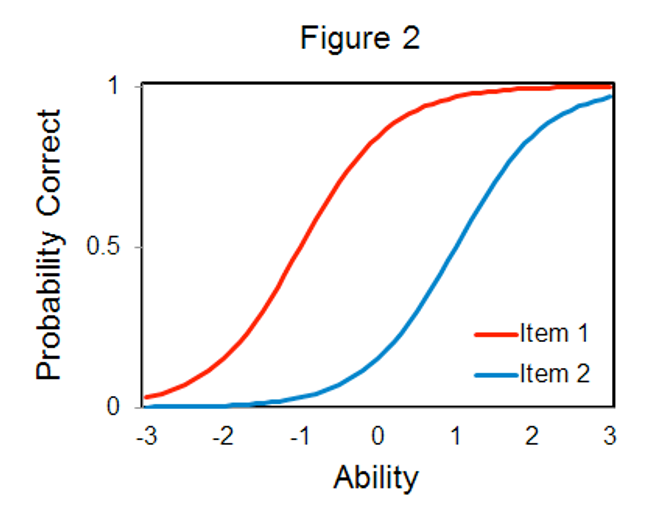
Item Response Theory
- a – item discrimination
- Tells you how well an item measures the latent variable
- Larger a values indicate better items
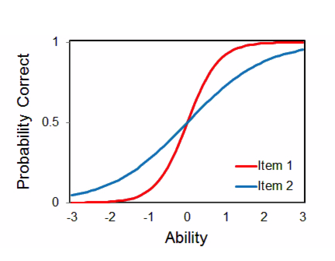
Item Response Theory
- 1 Parameter Logistic (1PL)
- Also known as the Rasch Model
- Only uses b
- 2 Parameter Logistic (2PL)
- Uses b and a
- 3 Parameter Logistic (3PL)
- Uses b, a, and c
Polytomous IRT
- A large portion of IRT focuses on dichotomous data (yes/no, correct/incorrect)
- Scoring is easier because you have “right” and “wrong” answers
- Separately, polytomous IRT focuses on data with multiple answers,
with no “right” answer
- Focus on ordering, meaning that low scores represent lower abilities, while high scores are higher abilities
- Likert type scales
Polytomous IRT
- Couple of types of models:
- Graded Response Model
- Generalized Partial Credit Model
- Partial Credit Model
Polytomous IRT
- A graded response model is simplest but can be hard to fit.
- Takes the number of categories – 1 and creates mini 2PLs for each of those boundary points (1-rest, 2-rest, 3-rest, etc.).
- You get probabilities of scoring at this level OR higher
Polytomous IRT
- The generalized partial credit and partial credit models account for the fact that you may not have each category used equally
- Therefore, you get the mini 2PLs for adjacent categories (1-2, 2-3, 3-4)
- If your categories are ordered (which you often want), these two estimations can be very similar.
- Another concern with the partial credit models is making sure that all categories have a point at which they are the most likely answer (thresholds)
Polytomous IRT
- Install the
mirt()library to use the multidimensional IRT package. - We are not covering multiple dimensional or multigroup IRT, but this package can do those models or polytomous estimation.
IRT Examples
- Let’s start with DIRT: Dichotomous IRT
- Dataset is the LSAT, which is scored as right or wrong
library(ltm)
#> Loading required package: MASS
#> Loading required package: msm
#> Loading required package: polycor
library(mirt)
#> Loading required package: stats4
#> Loading required package: lattice
#>
#> Attaching package: 'mirt'
#> The following object is masked from 'package:ltm':
#>
#> Science
data(LSAT)
head(LSAT)
#> Item 1 Item 2 Item 3 Item 4 Item 5
#> 1 0 0 0 0 0
#> 2 0 0 0 0 0
#> 3 0 0 0 0 0
#> 4 0 0 0 0 1
#> 5 0 0 0 0 1
#> 6 0 0 0 0 1Two Parameter Logistic
# Data frame name ~ z1 for one latent variable
#irt.param to give it to you standardized
LSAT.model <- ltm(LSAT ~ z1,
IRT.param = TRUE)2PL Output
- Difficulty = b = theta = ability
- Discrimination = a = how good the question is at figuring a person out.
coef(LSAT.model)
#> Dffclt Dscrmn
#> Item 1 -3.3597341 0.8253715
#> Item 2 -1.3696497 0.7229499
#> Item 3 -0.2798983 0.8904748
#> Item 4 -1.8659189 0.6885502
#> Item 5 -3.1235725 0.65745162PL Other Options
factor.scores(LSAT.model)
#>
#> Call:
#> ltm(formula = LSAT ~ z1, IRT.param = TRUE)
#>
#> Scoring Method: Empirical Bayes
#>
#> Factor-Scores for observed response patterns:
#> Item 1 Item 2 Item 3 Item 4 Item 5 Obs Exp z1 se.z1
#> 1 0 0 0 0 0 3 2.277 -1.895 0.795
#> 2 0 0 0 0 1 6 5.861 -1.479 0.796
#> 3 0 0 0 1 0 2 2.596 -1.460 0.796
#> 4 0 0 0 1 1 11 8.942 -1.041 0.800
#> 5 0 0 1 0 0 1 0.696 -1.331 0.797
#> 6 0 0 1 0 1 1 2.614 -0.911 0.802
#> 7 0 0 1 1 0 3 1.179 -0.891 0.803
#> 8 0 0 1 1 1 4 5.955 -0.463 0.812
#> 9 0 1 0 0 0 1 1.840 -1.438 0.796
#> 10 0 1 0 0 1 8 6.431 -1.019 0.801
#> 11 0 1 0 1 1 16 13.577 -0.573 0.809
#> 12 0 1 1 0 1 3 4.370 -0.441 0.813
#> 13 0 1 1 1 0 2 2.000 -0.420 0.813
#> 14 0 1 1 1 1 15 13.920 0.023 0.828
#> 15 1 0 0 0 0 10 9.480 -1.373 0.797
#> 16 1 0 0 0 1 29 34.616 -0.953 0.802
#> 17 1 0 0 1 0 14 15.590 -0.933 0.802
#> 18 1 0 0 1 1 81 76.562 -0.506 0.811
#> 19 1 0 1 0 0 3 4.659 -0.803 0.804
#> 20 1 0 1 0 1 28 24.989 -0.373 0.815
#> 21 1 0 1 1 0 15 11.463 -0.352 0.815
#> 22 1 0 1 1 1 80 83.541 0.093 0.831
#> 23 1 1 0 0 0 16 11.254 -0.911 0.802
#> 24 1 1 0 0 1 56 56.105 -0.483 0.812
#> 25 1 1 0 1 0 21 25.646 -0.463 0.812
#> 26 1 1 0 1 1 173 173.310 -0.022 0.827
#> 27 1 1 1 0 0 11 8.445 -0.329 0.816
#> 28 1 1 1 0 1 61 62.520 0.117 0.832
#> 29 1 1 1 1 0 28 29.127 0.139 0.833
#> 30 1 1 1 1 1 298 296.693 0.606 0.855Three Parameter Logistic
LSAT.model2 <- tpm(LSAT, #dataset
type = "latent.trait",
IRT.param = TRUE)
#> Warning in tpm(LSAT, type = "latent.trait", IRT.param = TRUE): Hessian matrix at convergence is not positive definite; unstable solution.3PL Output
- Difficulty = b = theta = ability
- Discrimination = a = how good the question is at figuring a person out.
- Guessing = c = how easy the item is to guess
coef(LSAT.model2)
#> Gussng Dffclt Dscrmn
#> Item 1 0.06389395 -3.3423509 0.8048523
#> Item 2 0.01567005 -1.5530954 0.6070241
#> Item 3 0.30088256 0.3301527 26.4150208
#> Item 4 0.06521055 -2.0342571 0.5700252
#> Item 5 0.02908352 -3.5826451 0.55235863PL Other Options
factor.scores(LSAT.model2)
#>
#> Call:
#> tpm(data = LSAT, type = "latent.trait", IRT.param = TRUE)
#>
#> Scoring Method: Empirical Bayes
#>
#> Factor-Scores for observed response patterns:
#> Item 1 Item 2 Item 3 Item 4 Item 5 Obs Exp z1 se.z1
#> 1 0 0 0 0 0 3 1.538 -1.659 0.865
#> 2 0 0 0 0 1 6 5.113 -1.245 0.876
#> 3 0 0 0 1 0 2 2.375 -1.245 0.879
#> 4 0 0 0 1 1 11 9.552 -0.815 0.891
#> 5 0 0 1 0 0 1 0.686 -1.659 0.865
#> 6 0 0 1 0 1 1 2.472 -1.245 0.876
#> 7 0 0 1 1 0 3 1.149 -1.245 0.879
#> 8 0 0 1 1 1 4 5.597 -0.815 0.891
#> 9 0 1 0 0 0 1 1.678 -1.205 0.878
#> 10 0 1 0 0 1 8 6.870 -0.777 0.890
#> 11 0 1 0 1 1 16 15.339 -0.330 0.906
#> 12 0 1 1 0 1 3 4.118 -0.777 0.890
#> 13 0 1 1 1 0 2 1.917 -0.774 0.893
#> 14 0 1 1 1 1 15 13.227 -0.330 0.906
#> 15 1 0 0 0 0 10 7.980 -1.053 0.883
#> 16 1 0 0 0 1 29 34.733 -0.619 0.895
#> 17 1 0 0 1 0 14 16.116 -0.616 0.898
#> 18 1 0 0 1 1 81 81.511 -0.166 0.910
#> 19 1 0 1 0 0 3 4.134 -1.053 0.883
#> 20 1 0 1 0 1 28 23.238 -0.619 0.895
#> 21 1 0 1 1 0 15 10.828 -0.616 0.898
#> 22 1 0 1 1 1 80 83.177 -0.166 0.912
#> 23 1 1 0 0 0 16 11.668 -0.577 0.897
#> 24 1 1 0 0 1 56 59.731 -0.129 0.908
#> 25 1 1 0 1 0 21 27.722 -0.122 0.910
#> 26 1 1 0 1 1 173 158.900 0.150 0.376
#> 27 1 1 1 0 0 11 8.068 -0.577 0.897
#> 28 1 1 1 0 1 61 63.489 -0.128 0.913
#> 29 1 1 1 1 0 28 29.695 -0.122 0.916
#> 30 1 1 1 1 1 298 303.369 0.503 0.407Compare Models
anova(LSAT.model, LSAT.model2)
#> Warning in anova.ltm(LSAT.model, LSAT.model2): either the two models are not nested or the model represented by 'object2' fell on a local maxima.
#>
#> Likelihood Ratio Table
#> AIC BIC log.Lik LRT df p.value
#> LSAT.model 4953.31 5002.38 -2466.65
#> LSAT.model2 4967.02 5040.64 -2468.51 -3.71 5 1Graded Partial Credit Model
gpcm.model1 <- mirt(data = poly.data1, #data
model = 1, #number of factors
itemtype = "gpcm") #poly model type
#> Iteration: 1, Log-Lik: -11632.167, Max-Change: 4.82538Iteration: 2, Log-Lik: -10643.196, Max-Change: 2.80519Iteration: 3, Log-Lik: -10466.648, Max-Change: 1.46456Iteration: 4, Log-Lik: -10407.465, Max-Change: 1.07570Iteration: 5, Log-Lik: -10391.165, Max-Change: 0.70497Iteration: 6, Log-Lik: -10380.881, Max-Change: 0.46272Iteration: 7, Log-Lik: -10377.111, Max-Change: 0.31365Iteration: 8, Log-Lik: -10374.263, Max-Change: 0.21356Iteration: 9, Log-Lik: -10372.203, Max-Change: 0.38073Iteration: 10, Log-Lik: -10369.957, Max-Change: 0.15524Iteration: 11, Log-Lik: -10368.478, Max-Change: 0.22565Iteration: 12, Log-Lik: -10367.024, Max-Change: 0.16375Iteration: 13, Log-Lik: -10364.773, Max-Change: 0.09306Iteration: 14, Log-Lik: -10363.888, Max-Change: 0.14681Iteration: 15, Log-Lik: -10363.042, Max-Change: 0.13197Iteration: 16, Log-Lik: -10360.346, Max-Change: 0.12133Iteration: 17, Log-Lik: -10359.333, Max-Change: 0.03727Iteration: 18, Log-Lik: -10359.002, Max-Change: 0.04397Iteration: 19, Log-Lik: -10358.801, Max-Change: 0.04719Iteration: 20, Log-Lik: -10358.591, Max-Change: 0.05133Iteration: 21, Log-Lik: -10358.410, Max-Change: 0.02077Iteration: 22, Log-Lik: -10358.337, Max-Change: 0.04891Iteration: 23, Log-Lik: -10358.184, Max-Change: 0.03701Iteration: 24, Log-Lik: -10358.050, Max-Change: 0.01716Iteration: 25, Log-Lik: -10358.005, Max-Change: 0.03666Iteration: 26, Log-Lik: -10357.894, Max-Change: 0.03487Iteration: 27, Log-Lik: -10357.797, Max-Change: 0.01621Iteration: 28, Log-Lik: -10357.767, Max-Change: 0.01415Iteration: 29, Log-Lik: -10357.694, Max-Change: 0.04601Iteration: 30, Log-Lik: -10357.617, Max-Change: 0.03283Iteration: 31, Log-Lik: -10357.524, Max-Change: 0.01379Iteration: 32, Log-Lik: -10357.474, Max-Change: 0.03921Iteration: 33, Log-Lik: -10357.424, Max-Change: 0.00916Iteration: 34, Log-Lik: -10357.416, Max-Change: 0.01006Iteration: 35, Log-Lik: -10357.380, Max-Change: 0.02822Iteration: 36, Log-Lik: -10357.343, Max-Change: 0.00895Iteration: 37, Log-Lik: -10357.337, Max-Change: 0.00870Iteration: 38, Log-Lik: -10357.310, Max-Change: 0.00980Iteration: 39, Log-Lik: -10357.287, Max-Change: 0.03201Iteration: 40, Log-Lik: -10357.257, Max-Change: 0.00613Iteration: 41, Log-Lik: -10357.241, Max-Change: 0.00621Iteration: 42, Log-Lik: -10357.226, Max-Change: 0.00628Iteration: 43, Log-Lik: -10357.203, Max-Change: 0.00560Iteration: 44, Log-Lik: -10357.190, Max-Change: 0.00178Iteration: 45, Log-Lik: -10357.186, Max-Change: 0.00399Iteration: 46, Log-Lik: -10357.179, Max-Change: 0.00227Iteration: 47, Log-Lik: -10357.176, Max-Change: 0.03798Iteration: 48, Log-Lik: -10357.155, Max-Change: 0.00415Iteration: 49, Log-Lik: -10357.155, Max-Change: 0.00413Iteration: 50, Log-Lik: -10357.148, Max-Change: 0.00366Iteration: 51, Log-Lik: -10357.144, Max-Change: 0.00372Iteration: 52, Log-Lik: -10357.131, Max-Change: 0.04537Iteration: 53, Log-Lik: -10357.110, Max-Change: 0.00132Iteration: 54, Log-Lik: -10357.109, Max-Change: 0.00345Iteration: 55, Log-Lik: -10357.106, Max-Change: 0.00159Iteration: 56, Log-Lik: -10357.105, Max-Change: 0.00040Iteration: 57, Log-Lik: -10357.104, Max-Change: 0.00058Iteration: 58, Log-Lik: -10357.104, Max-Change: 0.00021Iteration: 59, Log-Lik: -10357.104, Max-Change: 0.00047Iteration: 60, Log-Lik: -10357.104, Max-Change: 0.00016Iteration: 61, Log-Lik: -10357.104, Max-Change: 0.00013Iteration: 62, Log-Lik: -10357.104, Max-Change: 0.00025Iteration: 63, Log-Lik: -10357.104, Max-Change: 0.00012Iteration: 64, Log-Lik: -10357.104, Max-Change: 0.00010GPCM Output
- Can also get factor loadings here, with standardized coefficients to help us determine if they relate to their latent trait
summary(gpcm.model1) ##standardized coefficients
#> F1 h2
#> Q99_1 0.964 0.929
#> Q99_4 0.984 0.968
#> Q99_5 0.976 0.953
#> Q99_6 0.977 0.955
#> Q99_9 0.720 0.519
#>
#> SS loadings: 4.324
#> Proportion Var: 0.865
#>
#> Factor correlations:
#>
#> F1
#> F1 1GPCM Output
coef(gpcm.model1, IRTpars = T) ##coefficients
#> $Q99_1
#> a b1 b2 b3 b4 b5 b6
#> par 1.927 -1.905 -1.344 -1.107 -0.607 0.225 1.236
#>
#> $Q99_4
#> a b1 b2 b3 b4 b5 b6
#> par 2.941 -1.952 -1.67 -1.082 -0.592 0.121 0.972
#>
#> $Q99_5
#> a b1 b2 b3 b4 b5 b6
#> par 2.395 -2.052 -1.601 -1.255 -0.825 -0.093 0.979
#>
#> $Q99_6
#> a b1 b2 b3 b4 b5 b6
#> par 2.448 -2.014 -1.43 -1.168 -0.531 0.118 1.085
#>
#> $Q99_9
#> a b1 b2 b3 b4 b5 b6
#> par 0.553 -1.671 -2.488 -1.202 -0.113 -1.115 -0.296
#>
#> $GroupPars
#> MEAN_1 COV_11
#> par 0 1
head(fscores(gpcm.model1)) ##factor scores
#> F1
#> [1,] -0.6805579
#> [2,] -2.7481783
#> [3,] -1.2486173
#> [4,] -1.4226850
#> [5,] -2.7481783
#> [6,] -2.7481783GPCM Plots
plot(gpcm.model1, type = "trace") ##curves for all items at once
itemplot(gpcm.model1, 5, type = "trace")